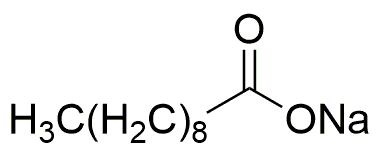Sodium decanoate is widely utilized in research focused on:
- Food Industry: As a food additive, it acts as an emulsifier and stabilizer, improving the texture and shelf life of various products, such as baked goods and dairy items.
- Pharmaceuticals: It serves as a surfactant in drug formulations, enhancing the solubility and bioavailability of active ingredients, which is crucial for effective medication delivery.
- Cosmetics: In personal care products, it functions as a thickening agent and emulsifier, providing a smooth application and improving product stability.
- Biotechnology: Used in cell culture media, it supports the growth of cells by providing essential fatty acids, which are vital for cell membrane integrity and function.
- Cleaning Products: Its properties make it effective in formulating biodegradable detergents and soaps, appealing to environmentally conscious consumers seeking sustainable cleaning solutions.
General Information
Properties
Safety and Regulations
Applications
Sodium decanoate is widely utilized in research focused on:
- Food Industry: As a food additive, it acts as an emulsifier and stabilizer, improving the texture and shelf life of various products, such as baked goods and dairy items.
- Pharmaceuticals: It serves as a surfactant in drug formulations, enhancing the solubility and bioavailability of active ingredients, which is crucial for effective medication delivery.
- Cosmetics: In personal care products, it functions as a thickening agent and emulsifier, providing a smooth application and improving product stability.
- Biotechnology: Used in cell culture media, it supports the growth of cells by providing essential fatty acids, which are vital for cell membrane integrity and function.
- Cleaning Products: Its properties make it effective in formulating biodegradable detergents and soaps, appealing to environmentally conscious consumers seeking sustainable cleaning solutions.
Documents
Safety Data Sheets (SDS)
The SDS provides comprehensive safety information on handling, storage, and disposal of the product.
Product Specification (PS)
The PS provides a comprehensive breakdown of the product’s properties, including chemical composition, physical state, purity, and storage requirements. It also details acceptable quality ranges and the product's intended applications.
Certificates of Analysis (COA)
Search for Certificates of Analysis (COA) by entering the products Lot Number. Lot and Batch Numbers can be found on a product’s label following the words ‘Lot’ or ‘Batch’.
*Catalog Number
*Lot Number
Certificates Of Origin (COO)
This COO confirms the country where the product was manufactured, and also details the materials and components used in it and whether it is derived from natural, synthetic, or other specific sources. This certificate may be required for customs, trade, and regulatory compliance.
*Catalog Number
*Lot Number
Safety Data Sheets (SDS)
The SDS provides comprehensive safety information on handling, storage, and disposal of the product.
DownloadProduct Specification (PS)
The PS provides a comprehensive breakdown of the product’s properties, including chemical composition, physical state, purity, and storage requirements. It also details acceptable quality ranges and the product's intended applications.
DownloadCertificates of Analysis (COA)
Search for Certificates of Analysis (COA) by entering the products Lot Number. Lot and Batch Numbers can be found on a product’s label following the words ‘Lot’ or ‘Batch’.
*Catalog Number
*Lot Number
Certificates Of Origin (COO)
This COO confirms the country where the product was manufactured, and also details the materials and components used in it and whether it is derived from natural, synthetic, or other specific sources. This certificate may be required for customs, trade, and regulatory compliance.

